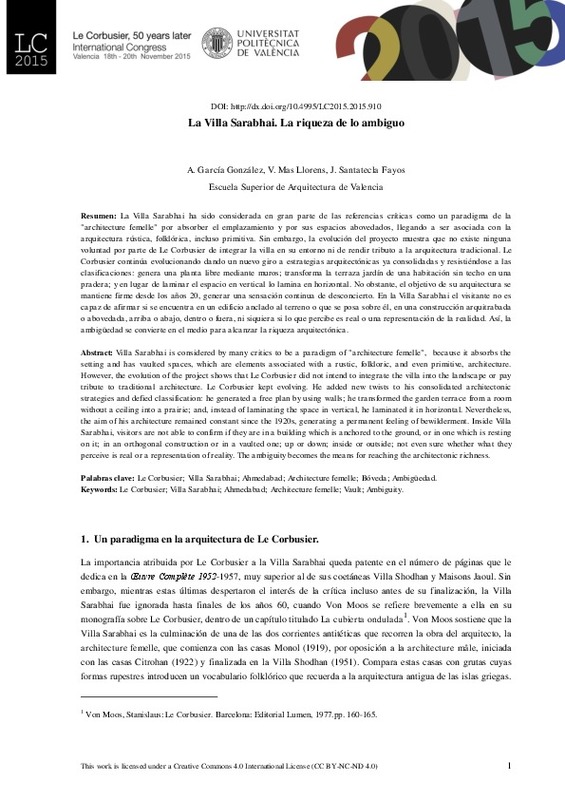JavaScript is disabled for your browser. Some features of this site may not work without it.
Buscar en RiuNet
Listar
Mi cuenta
Estadísticas
Ayuda RiuNet
Admin. UPV
La Villa Sarabhai. La riqueza de lo ambiguo
Mostrar el registro sencillo del ítem
Ficheros en el ítem
| dc.contributor.author | García González, Andrea
|
es_ES |
| dc.contributor.author | Mas Llorens, Vicente
|
es_ES |
| dc.contributor.author | Santatecla Fayos, José
|
es_ES |
| dc.date.accessioned | 2018-02-09T08:26:47Z | |
| dc.date.available | 2018-02-09T08:26:47Z | |
| dc.date.issued | 2016-03-03 | |
| dc.identifier.isbn | 9788490483732 | |
| dc.identifier.uri | http://hdl.handle.net/10251/97560 | |
| dc.description.abstract | [EN] Villa Sarabhai is considered by many critics to be a paradigm of "architecture femelle", because it absorbs the setting and has vaulted spaces, which are elements associated with a rustic, folkloric, and even primitive, architecture. However, the evolution of the project shows that Le Corbusier did not intend to integrate the villa into the landscape or pay tribute to traditional architecture. Le Corbusier kept evolving. He added new twists to his consolidated architectonic strategies and defied classification: he generated a free plan by using walls; he transformed the garden terrace from a room without a ceiling into a prairie; and, instead of laminating the space in vertical, he laminated it in horizontal. Nevertheless, the aim of his architecture remained constant since the 1920s, generating a permanent feeling of bewilderment. Inside Villa Sarabhai, visitors are not able to confirm if they are in a building which is anchored to the ground, or in one which is resting on it; in an orthogonal construction or in a vaulted one; up or down; inside or outside; not even sure whether what they perceive is real or a representation of reality. The ambiguity becomes the means for reaching the architectonic richness. | es_ES |
| dc.description.abstract | [ES] La Villa Sarabhai ha sido considerada en gran parte de las referencias críticas como un paradigma de la "architecture femelle" por absorber el emplazamiento y por sus espacios abovedados, llegando a ser asociada con la arquitectura rústica, folklórica, incluso primitiva. Sin embargo, la evolución del proyecto muestra que no existe ninguna voluntad por parte de Le Corbusier de integrar la villa en su entorno ni de rendir tributo a la arquitectura tradicional. Le Corbusier continúa evolucionando dando un nuevo giro a estrategias arquitectónicas ya consolidadas y resistiéndose a las clasificaciones: genera una planta libre mediante muros; transforma la terraza jardín de una habitación sin techo en una pradera; y en lugar de laminar el espacio en vertical lo lamina en horizontal. No obstante, el objetivo de su arquitectura se mantiene firme desde los años 20, generar una sensación continua de desconcierto. En la Villa Sarabhai el visitante no es capaz de afirmar si se encuentra en un edificio anclado al terreno o que se posa sobre él, en una construcción arquitrabada o abovedada, arriba o abajo, dentro o fuera, ni siquiera si lo que percibe es real o una representación de la realidad. Así, la ambigüedad se convierte en el medio para alcanzar la riqueza arquitectónica. | es_ES |
| dc.format.extent | 18 | es_ES |
| dc.language | Español | es_ES |
| dc.publisher | Editorial Universitat Politècnica de València | es_ES |
| dc.relation.ispartof | LE CORBUSIER. 50 AÑOS DESPUÉS | es_ES |
| dc.rights | Reconocimiento - No comercial - Sin obra derivada (by-nc-nd) | es_ES |
| dc.subject | Architecture | es_ES |
| dc.subject | Le Corbusier | es_ES |
| dc.subject | Modern movement | es_ES |
| dc.subject.classification | PROYECTOS ARQUITECTONICOS | es_ES |
| dc.title | La Villa Sarabhai. La riqueza de lo ambiguo | es_ES |
| dc.type | Capítulo de libro | es_ES |
| dc.type | Comunicación en congreso | es_ES |
| dc.identifier.doi | 10.4995/LC2015.2015.910 | |
| dc.rights.accessRights | Abierto | es_ES |
| dc.contributor.affiliation | Universitat Politècnica de València. Departamento de Proyectos Arquitectónicos - Departament de Projectes Arquitectònics | es_ES |
| dc.contributor.affiliation | Universitat Politècnica de València. Escuela Técnica Superior de Arquitectura - Escola Tècnica Superior d'Arquitectura | es_ES |
| dc.description.bibliographicCitation | García González, A.; Mas Llorens, V.; Santatecla Fayos, J. (2016). La Villa Sarabhai. La riqueza de lo ambiguo. En LE CORBUSIER. 50 AÑOS DESPUÉS. Editorial Universitat Politècnica de València. 786-803. https://doi.org/10.4995/LC2015.2015.910 | es_ES |
| dc.description.accrualMethod | OCS | es_ES |
| dc.relation.conferencename | LC2015 - Le Corbusier, 50 years later | es_ES |
| dc.relation.conferencedate | November 18-20,2015 | es_ES |
| dc.relation.conferenceplace | Valencia, Spain | es_ES |
| dc.relation.publisherversion | http://ocs.editorial.upv.es/index.php/LC2015/LC2015/paper/view/910 | es_ES |
| dc.description.upvformatpinicio | 786 | es_ES |
| dc.description.upvformatpfin | 803 | es_ES |
| dc.type.version | info:eu-repo/semantics/publishedVersion | es_ES |
| dc.relation.pasarela | OCS\910 | es_ES |








